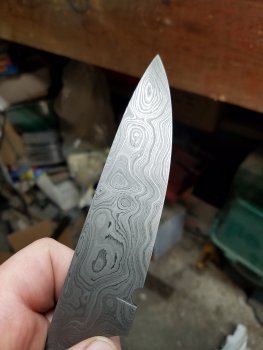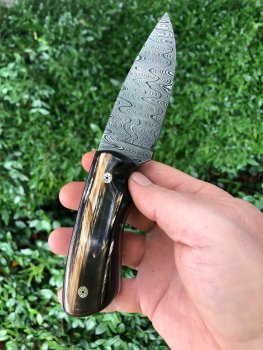You are using an out of date browser. It may not display this or other websites correctly.
You should upgrade or use an alternative browser.
You should upgrade or use an alternative browser.
Alabama Damascus
- Thread starter opaul
- Start date
mike miller
KNIFE MAKER
Brad makes some good stuff. I have made my own but now mainly just use his. He has branched out and makes several nice patterns. He is always ready to help you out if you have any problems.
Chris Railey
Well-Known Member
Anyone know how it reacts to simple HT?
bladegrinder
Well-Known Member
I've used a lot of it over the years and still use it occasionally. I do a coffee etch at the end, more often than not it really makes the pattern "pop".
I like it, it hardens nicely and you can't beat the price, although on occasion I have found inclusions in it.
The owner, Brad Vice guarantees all his Damascus and he has taken care of me on the couple times I couldn't work around any flaws I found. he's a stand up guy.
I like it, it hardens nicely and you can't beat the price, although on occasion I have found inclusions in it.
The owner, Brad Vice guarantees all his Damascus and he has taken care of me on the couple times I couldn't work around any flaws I found. he's a stand up guy.
Randy Lucius
Well-Known Member
From the Alabama website for HT'ing: http://www.alabamadamascussteel.com/blog/ads-ht-etch/
Heat Treatment:
If you heat treat yourself, simply take the steel to a temperature where a magnet will not stick. Be careful, this is high carbon tool steel and if you are inattentive decarburization will occur.
If you do not use method above by “eye” or magnet, preheat oven to 1550 degrees F. Hang blade, allow blade to reach furnace temperature, then soak for two minutes at that temperature.
Quench IMMEDIATELY in quenching oil (10 weight hydraulic oil). Immerse blade point downward.
Draw:
Pre-Heat oven up to 350 degrees, place blades in the oven and then after 1 hour turn off the oven and let the blades cool down to room temperature, draw again if you wish for a double draw.
ETCHING PROCESS:
USE EXTREME CAUTION WHEN USING ACID
Degrease with acetone, mix ferric chloride (brand name Etchant, from radio shack) with distilled white vinegar, mix 60% ferric chloride and 40% white vinegar. Dip blade in a plastic container containing the acid mixture, let stand for a few minutes and remove to see pattern,( now that is the best part to see the pattern come out on the blade), rinse blade with warm water and put it back in the acid till the desired depth is achieved in the blade, it could take several minutes to get the depth and contrast you want(you may or may not need to wipe oxidation away while rinsing with your finger. It all depends on the contrast that you are getting and the effect that you are trying to achieve.), but on the last dip remove blade from acid and allow the black oxidation to stay on the blade rinse in warm water & rinse in baking soda to neutralize the acid, (Windex will work also) dry quickly with blow dryer, or some other means, to allow the black oxidation to set, and after it is completely dry, spray with wd-40, tri-flow, Break- Free, or clear paint.
Heat Treatment:
If you heat treat yourself, simply take the steel to a temperature where a magnet will not stick. Be careful, this is high carbon tool steel and if you are inattentive decarburization will occur.
If you do not use method above by “eye” or magnet, preheat oven to 1550 degrees F. Hang blade, allow blade to reach furnace temperature, then soak for two minutes at that temperature.
Quench IMMEDIATELY in quenching oil (10 weight hydraulic oil). Immerse blade point downward.
Draw:
Pre-Heat oven up to 350 degrees, place blades in the oven and then after 1 hour turn off the oven and let the blades cool down to room temperature, draw again if you wish for a double draw.
ETCHING PROCESS:
USE EXTREME CAUTION WHEN USING ACID
Degrease with acetone, mix ferric chloride (brand name Etchant, from radio shack) with distilled white vinegar, mix 60% ferric chloride and 40% white vinegar. Dip blade in a plastic container containing the acid mixture, let stand for a few minutes and remove to see pattern,( now that is the best part to see the pattern come out on the blade), rinse blade with warm water and put it back in the acid till the desired depth is achieved in the blade, it could take several minutes to get the depth and contrast you want(you may or may not need to wipe oxidation away while rinsing with your finger. It all depends on the contrast that you are getting and the effect that you are trying to achieve.), but on the last dip remove blade from acid and allow the black oxidation to stay on the blade rinse in warm water & rinse in baking soda to neutralize the acid, (Windex will work also) dry quickly with blow dryer, or some other means, to allow the black oxidation to set, and after it is completely dry, spray with wd-40, tri-flow, Break- Free, or clear paint.
I have read the steels used in Alabama Damascus is usually 3 types, 5160, 203E, and 15N20 or 52100. Sometimes nickel 200 is added also.
The steels used to make up Alabama Damascus billets are 5160 (spring steel) 203E (low carbon high impact High nickel mild steel alloy) 15N20 (band saw blade material), 52100 (ball bearing steel), nickel 200 is added at times also.
The steels used to make up Alabama Damascus billets are 5160 (spring steel) 203E (low carbon high impact High nickel mild steel alloy) 15N20 (band saw blade material), 52100 (ball bearing steel), nickel 200 is added at times also.
mike miller
KNIFE MAKER
You have all 4 steels in his makeup at a finished 416 layer billet. 5160, 203 DE, 15n20 and 5210. I know Ray Kirk had delivered some virgin 15n20 to him on his way to Atlanta.
Why in the world do they insist on using so many different steel alloys in the Damascus? A simple 1080 and 15N20 would be a good mix and not be so warp prone. All those different alloys will have different expansion rates when HT'ing giving rise to possible warp problems.
mike miller
KNIFE MAKER
They first started with 5160 and the 203 DE. then the 15n20 and 52100 was added to improve the carbon content .




